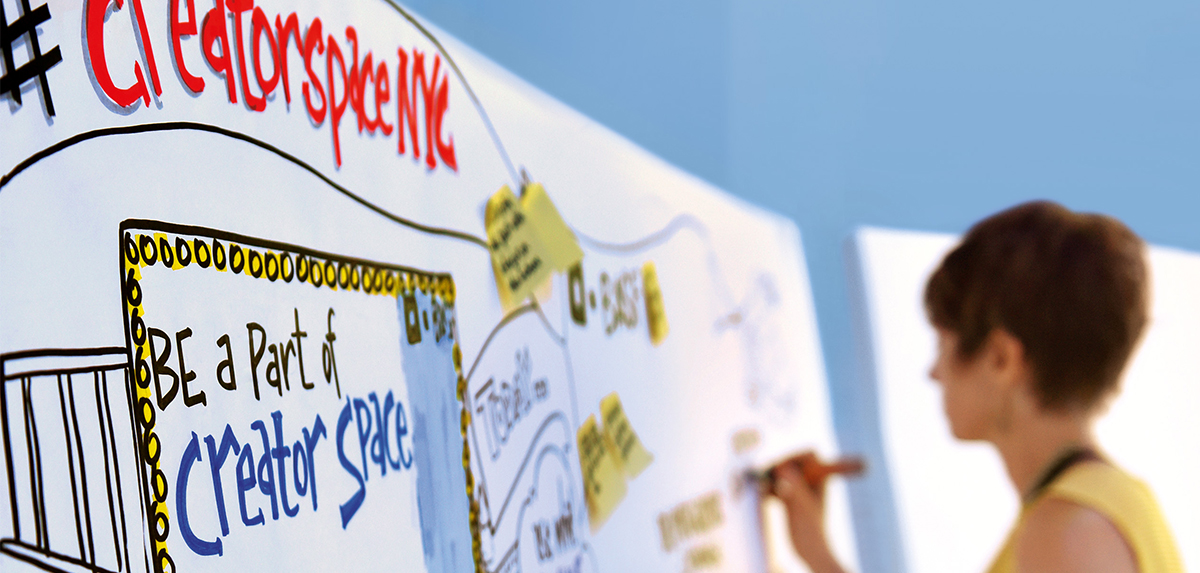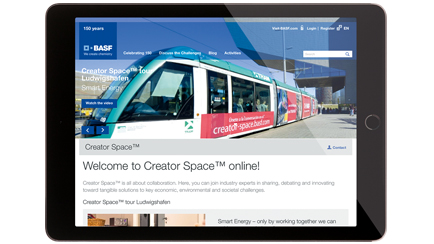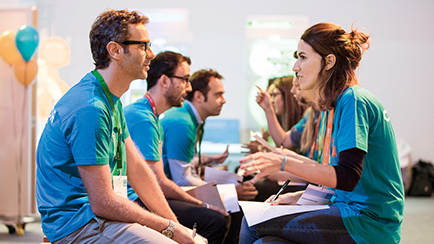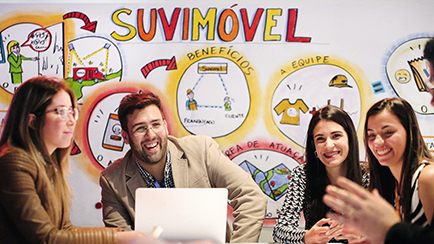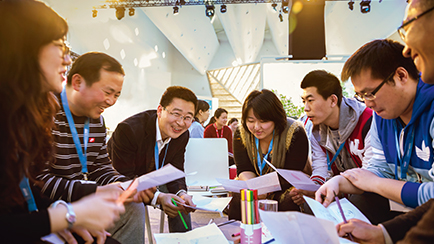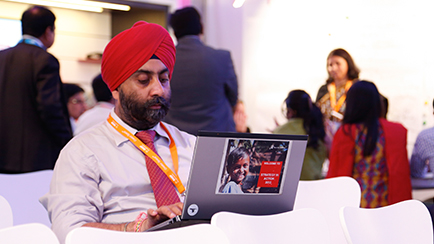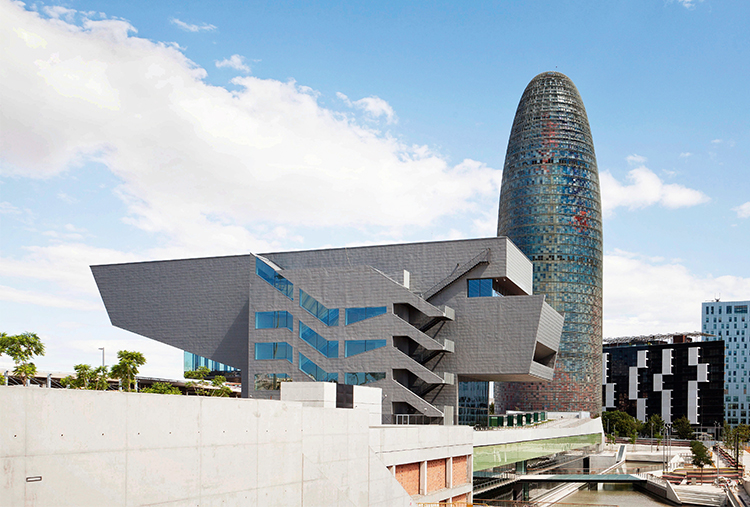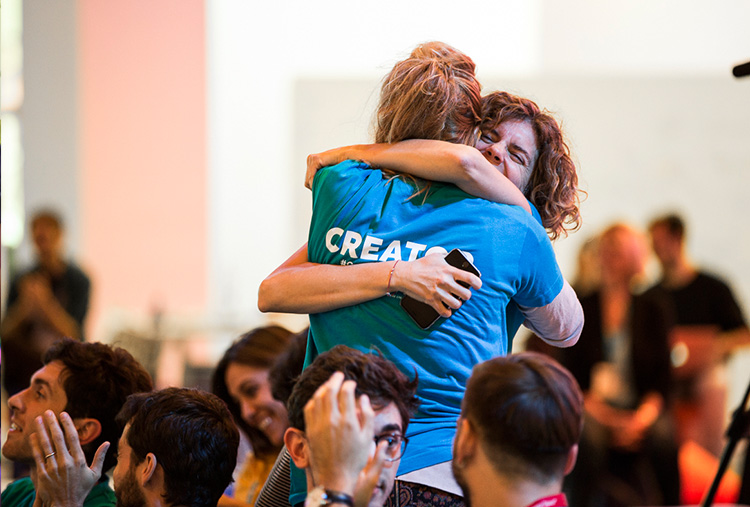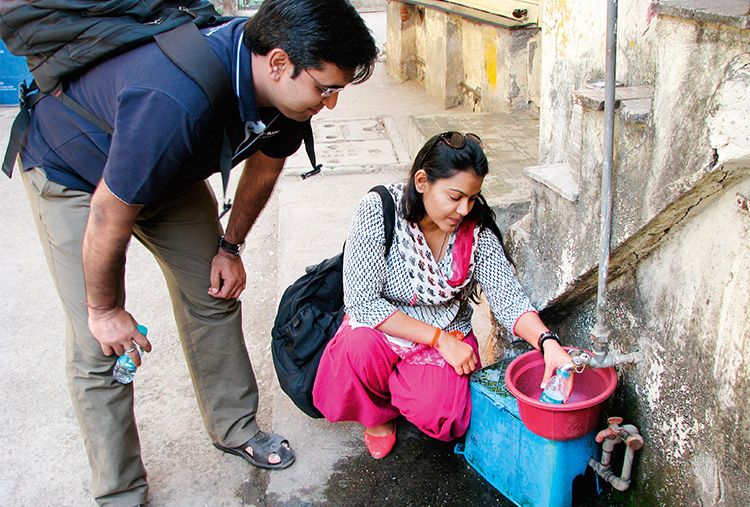What an anniversary can do
The knowledge and creativity of many minds can give rise to extraordinary ideas. This was the inspiration behind our anniversary program. Dubbed Creator Space™, it was a very special way to celebrate 150 years of BASF. We organized a tour around the world, bringing scientists, customers, employees and partners from all over the globe together at one table and launching an online platform to connect everyone. Ideas were proposed surrounding three main themes: urban living, smart energy and food. We call this “co-creation.” It is one way to fill our idea pipeline for the future and create value.
Which ideas emerged

Barcelona
Kuala Lumpur
Ludwigshafen
Mumbai
New York
Osaka
São Paulo
Shanghai
Chicago
Jaunde
The Creator Space™ tour circumnavigated the globe, offering a broad program of presentations, workshops and cultural events for customers, partners, experts and employees.
International researchers and experts met in global science conventions to discuss new findings and work together on approaches for solutions.
Finally, fresh, clean water for the 200 children at the Notre Dame Orphanage, now that a pump has been installed in the well of the yard. The project team planned this “Connected to Care” project beforehand for the Le Coeur sur la Main foundation in Evry, France. Lessons at the primary school connected to the orphanage also taught the children about the importance of handwashing.
Kuala Lumpur
Employees get involved
A community needs engaged citizens in order to thrive. BASF helped its employees carry out charitable projects through its global team competition, “Connected to Care.” Around 500 project proposals were submitted from around the globe; 150 of these received up to €5,000 apiece, amounting to a total of €700,000 in support. BASF also promotes employees’ volunteer work outside of its anniversary celebrations, through various regional projects.
Finally, fresh, clean water for the 200 children at the Notre Dame Orphanage, now that a pump has been installed in the well of the yard. The project team planned this “Connected to Care” project beforehand for the Le Coeur sur la Main foundation in Evry, France. Lessons at the primary school connected to the orphanage also taught the children about the importance of handwashing.
Lessons at the primary school connected to the orphanage also taught the children about the importance of handwashing.
Everyone pitching in: In March 2015, a fire destroyed part of the Timu Yuan Chin Temple, a living symbol of Buddhist religion and culture.
A team of BASF employees volunteered to clean up the temple and remove the rubble from the fire. The initiative was run in collaboration with Erasmus Mundus Students and Alumni Association (EMA).
-
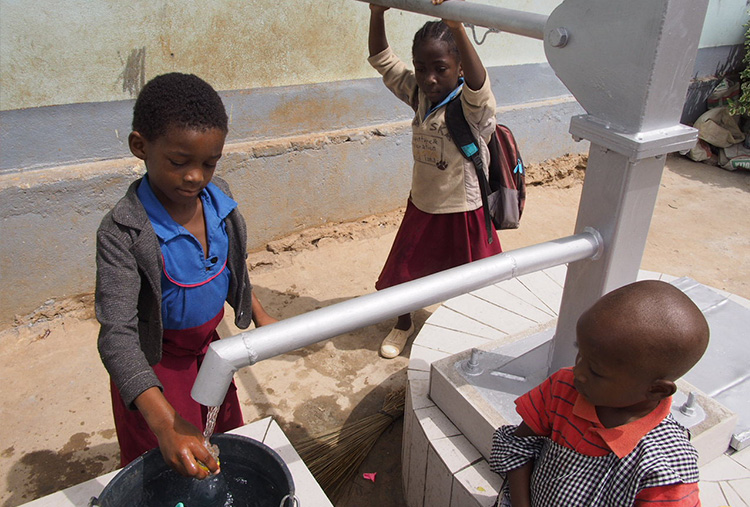
Finally, fresh, clean water for the 200 children at the Notre Dame Orphanage, now that a pump has been installed in the well of the yard. The project team planned this “Connected to Care” project beforehand for the Le Coeur sur la Main foundation in Evry, France. Lessons at the primary school connected to the orphanage also taught the children about the importance of handwashing.
-
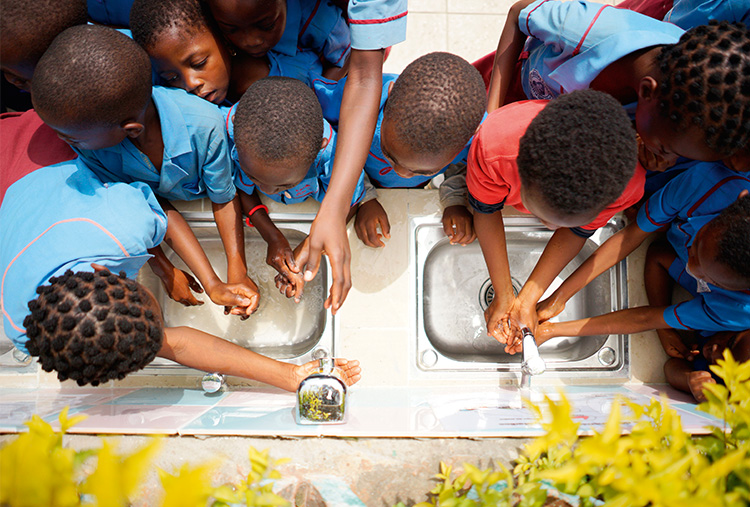
Lessons at the primary school connected to the orphanage also taught the children about the importance of handwashing.
-
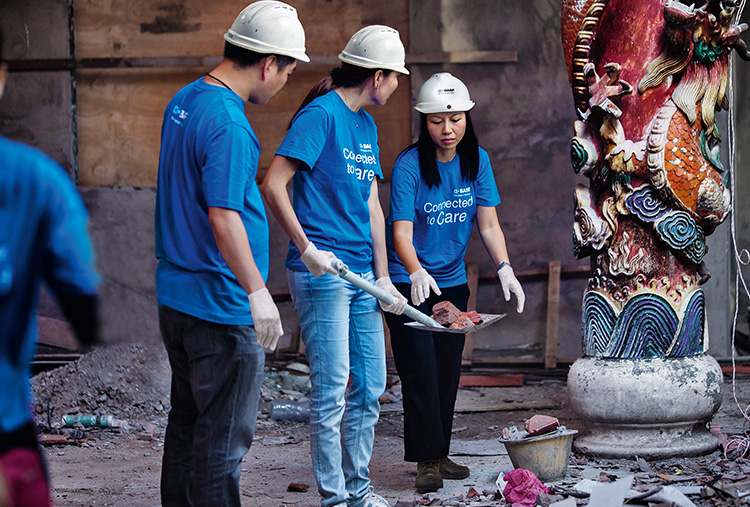
Everyone pitching in: In March 2015, a fire destroyed part of the Timu Yuan Chin Temple, a living symbol of Buddhist religion and culture.
-
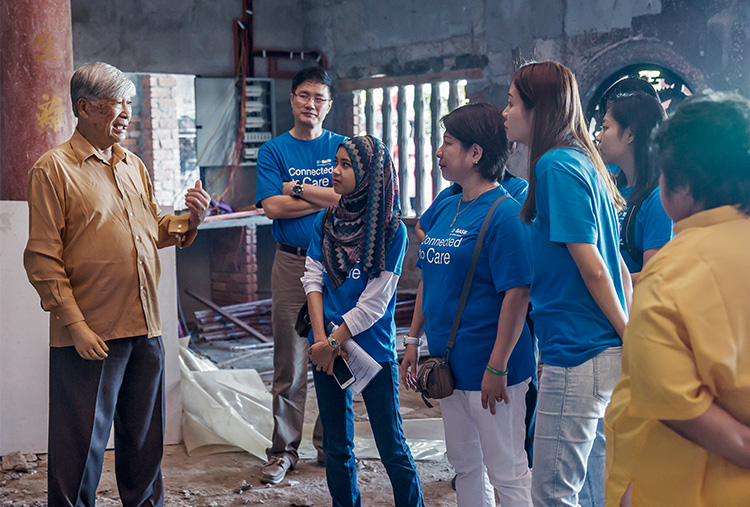
A team of BASF employees volunteered to clean up the temple and remove the rubble from the fire. The initiative was run in collaboration with Erasmus Mundus Students and Alumni Association (EMA).
Safe and clean through the city: Participants at a joint workshop held by BASF and Daimler discussed new technologies and materials for making even more efficient and environmentally friendly vehicles in the future.
Ludwigshafen
The bus to the future
Environmentally-friendly technologies, comfortable interiors, a lighter chassis – there was no lack of original ideas and visions at a joint customer innovation workshop. Together with experts from Daimler Buses, BASF employees from various fields discussed solutions for future bus challenges, ranging from special coatings and new lightweight engineering concepts to possibilities for preventing vandalism. This brainstorming gave rise to project ideas providing new inspiration for the bus of the future.
Safe and clean through the city: Participants at a joint workshop held by BASF and Daimler discussed new technologies and materials for making even more efficient and environmentally friendly vehicles in the future.
Green technologies, comfortable interiors, a lighter chassis – there was no lack of original ideas and visions at the joint customer innovation workshop.
Green technologies, comfortable interiors, a lighter chassis – there was no lack of original ideas and visions at the joint customer innovation workshop.
The Co-Creation Workshop with Daimler Buses included a peek behind the curtain in a tour through the production floors.
-
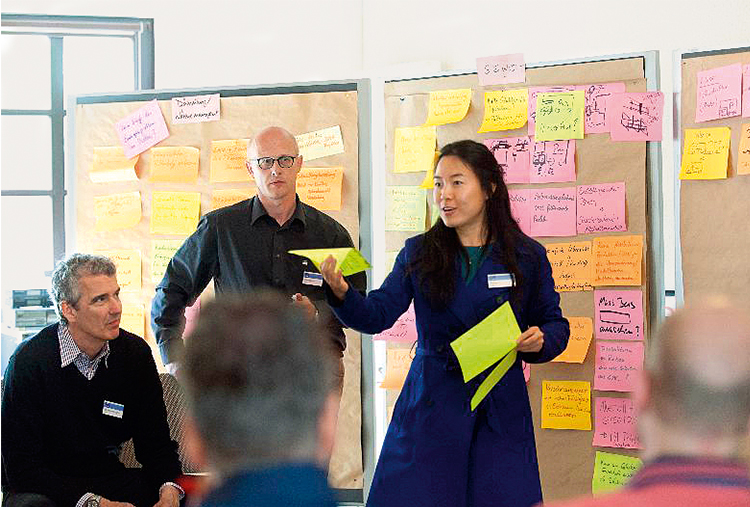
Safe and clean through the city: Participants at a joint workshop held by BASF and Daimler discussed new technologies and materials for making even more efficient and environmentally friendly vehicles in the future.
-
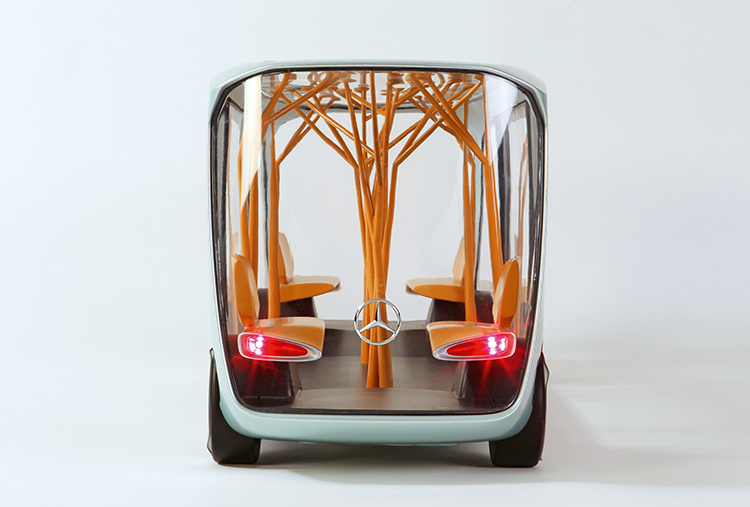
Green technologies, comfortable interiors, a lighter chassis – there was no lack of original ideas and visions at the joint customer innovation workshop.
-
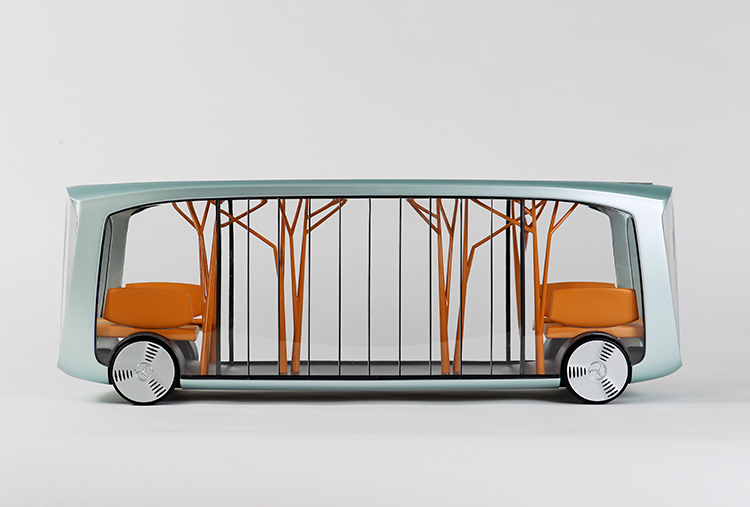
Green technologies, comfortable interiors, a lighter chassis – there was no lack of original ideas and visions at the joint customer innovation workshop.
-
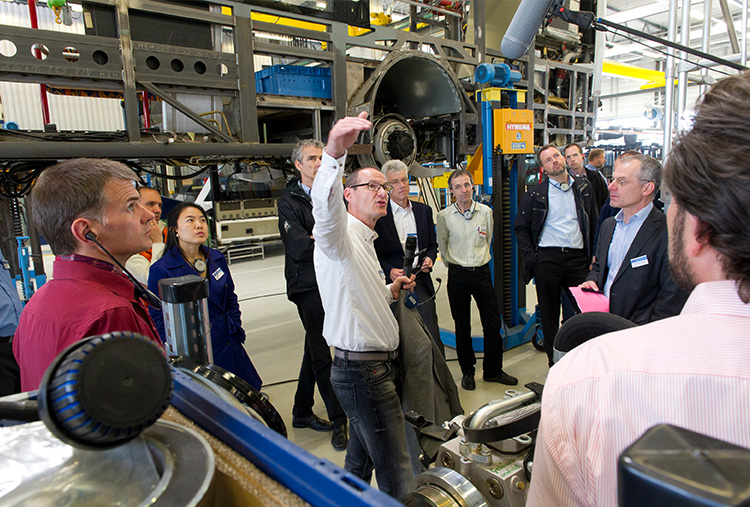
The Co-Creation Workshop with Daimler Buses included a peek behind the curtain in a tour through the production floors.
90 minutes of water a day: For some residents of the Indian metropolis Mumbai, it is crucial to store drinking water in containers.
Mumbai
A change in perspective
How can we improve access to clean water in a rapidly growing metropolis like Mumbai? Around 250 experts from industry, the nonprofit sector, science and society all set to work on this question. One example was a joint project initiated by BASF and Save the Children, in which several employees dove into everyday life in Mumbai for one week. Some were guests in families who have running water for only 90 minutes a day. It is important for these families to store water in containers. But space is often at a premium, and the water can sometimes get contaminated. For Nitin Sharma, BASF India Ltd., joining a family for a week was an indispensable part of the project: “We can then assess whether and how innovations from BASF can contribute to the solution, whether it’s a new material for stackable water containers, an innovative filter system, or a combination of existing systems. It’s crucial – for commercial success as well – to understand what the people in the community really need.”
90 minutes of water a day: For some residents of the Indian metropolis Mumbai, it is crucial to store drinking water in containers.
For one week, employees of BASF and Save the Children learned in person what this means for many families on a daily basis.
How can we improve quality of life in New York’s Red Hook neighborhood? Interested residents worked on answers to this question together with experts from science, industry, and think tanks at the two-day Creator Space™ Summit.
New York
New York’s next trendy neighborhood?
How can we improve urban development and the housing situation in metropolises like New York, where the population is booming? This was the question posed by involved citizens, students, engineers and other participants of a design competition in New York. The assignment: How might Van Brunt Street in Red Hook, Brooklyn, look in the future? The Red Hook neighborhood is marked by limited access to public transportation. Buildings in need of renovation, susceptibility to hurricane and flood damage, and a high level of socio-economic diversity all demand creative and practical solutions to support the neighborhood’s future. The winning concept included an ingenious canal system and the idea of invigorating the local economy with a “Made in Red Hook” product label. BASF plans to continue these discussions and use the ideas for concrete proposals to benefit Red Hook and other cities.
How can we improve quality of life in New York’s Red Hook neighborhood? Interested residents worked on answers to this question together with experts from science, industry, and think tanks at the two-day Creator Space™ Summit.
Smart design: How can Red Hook’s community be optimally connected to public transportation and gain better access to social and cultural amenities?
The design competition in New York posed the question: How could Van Brunt Street in Red Hook, Brooklyn, look in the future?
A multi-sensory experience awaited visitors to “Corners,” an interactive film installation by the artist Emilie Baltz exploring how a bakery, a wine store and a roof garden shape social life in three areas of New York City.
-

How can we improve quality of life in New York’s Red Hook neighborhood? Interested residents worked on answers to this question together with experts from science, industry, and think tanks at the two-day Creator Space™ Summit.
-
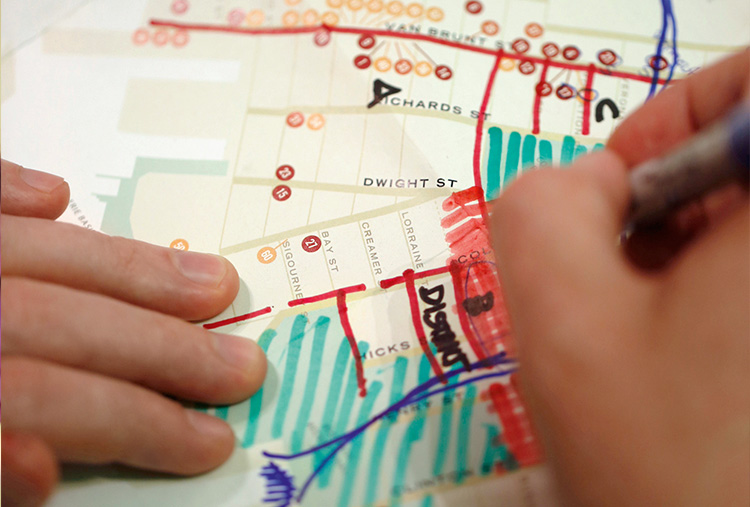
Smart design: How can Red Hook’s community be optimally connected to public transportation and gain better access to social and cultural amenities?
-

The design competition in New York posed the question: How could Van Brunt Street in Red Hook, Brooklyn, look in the future?
-
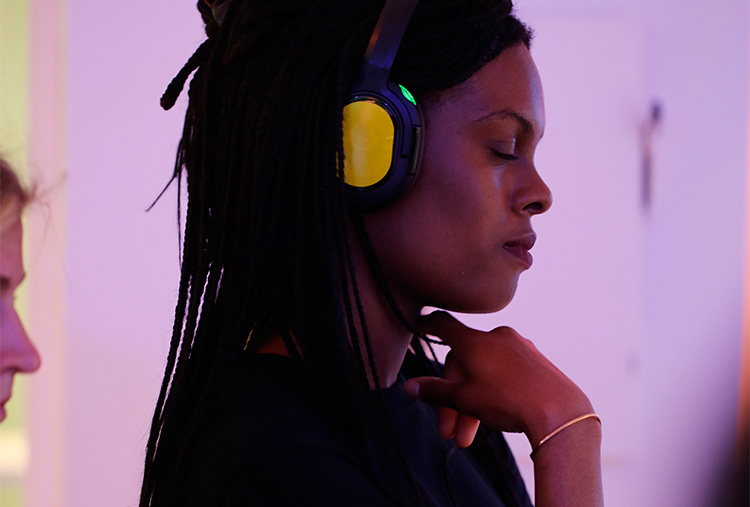
A multi-sensory experience awaited visitors to “Corners,” an interactive film installation by the artist Emilie Baltz exploring how a bakery, a wine store and a roof garden shape social life in three areas of New York City.
The one-week tour stop in New York provided a lot of space for creativity. The results of this creative exchange were taken down by a “graphic recording,” the simultaneous illustration of ideas.
New York
Moving for power
A group of mobility experts and fitness fans from all over the world got together for a jamming session between BASF and adidas in New York. The topic: the future of urban transportation. The results of the exchange ranged from a smartphone app that networks bicyclists to a floating residential neighborhood on the Hudson River. One promising idea was to establish a volunteer cyclists’ association that generates electricity by riding a bike. This could supply schools, libraries and other community organizations.
The one-week tour stop in New York provided a lot of space for creativity. The results of this creative exchange were taken down by a “graphic recording,” the simultaneous illustration of ideas.
Communal sportsmanship: Participants in the jam session held by BASF and adidas developed an idea for a cycling association that uses the energy generated from pedaling for the public good.
A group of mobility experts and fitness fans from all over the world got together for the jamming session with adidas. The topic: the future of urban transportation.
Participants at the jam session worked on solutions for the future of urban mobility.
-
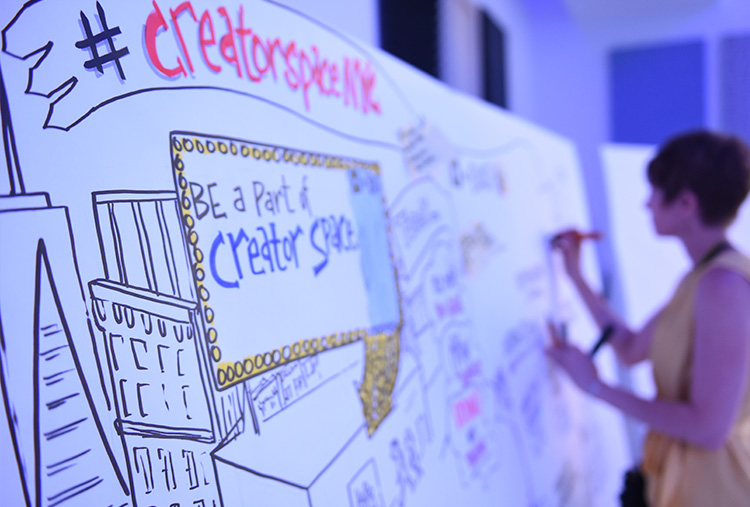
The one-week tour stop in New York provided a lot of space for creativity. The results of this creative exchange were taken down by a “graphic recording,” the simultaneous illustration of ideas.
-
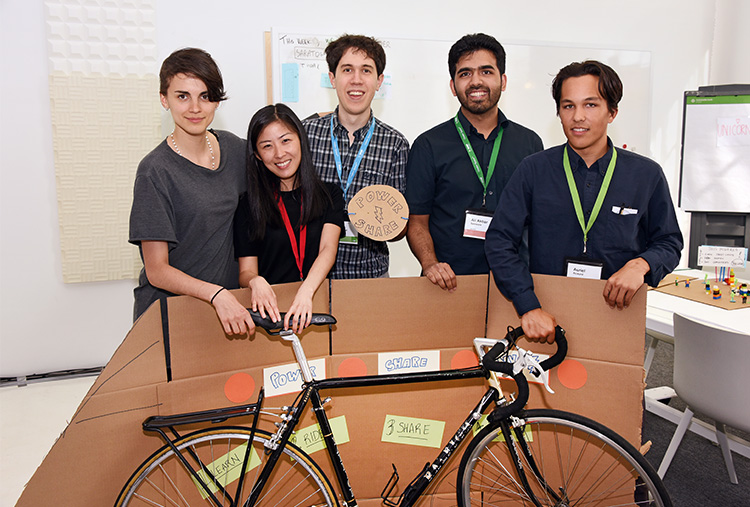
Communal sportsmanship: Participants in the jam session held by BASF and adidas developed an idea for a cycling association that uses the energy generated from pedaling for the public good.
-
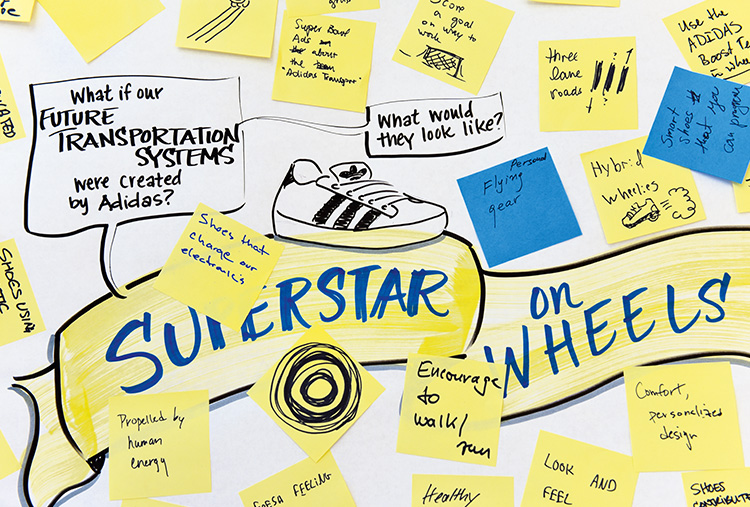
A group of mobility experts and fitness fans from all over the world got together for the jamming session with adidas. The topic: the future of urban transportation.
-
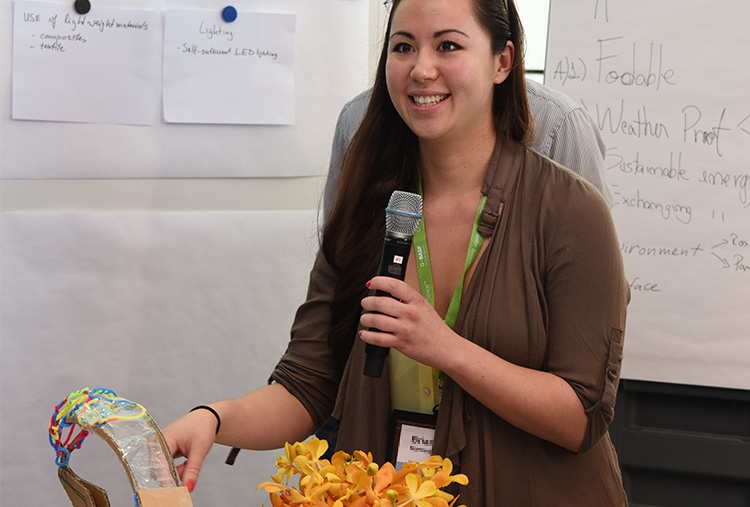
Participants at the jam session worked on solutions for the future of urban mobility.
Around 50 employees of Panasonic Automotive & Industrial Systems Company and BASF discussed a range of current energy topics, such as high-performance electronics, sensors, and energy harvesting, at a Co-Creation workshop in Japan.
Osaka
An energetic partnership
In Japan, around 50 employees from BASF and Panasonic Automotive & Industrial Systems Company came together in a co-creation workshop to discuss current energy-related topics, ranging from power electronics to sensors and energy harvesting. From numerous innovative suggestions, the companies chose the most promising ideas surrounding the topic “systems for storing heat energy through chemical reactions” as a basis for future collaboration and to benefit from knowledge exchange. Panasonic and BASF, who had not had a partnership prior to the workshop, also plan to work together in research and development. The two companies are currently hashing out the details of the collaboration.
Around 50 employees of Panasonic Automotive & Industrial Systems Company and BASF discussed a range of current energy topics, such as high-performance electronics, sensors, and energy harvesting, at a Co-Creation workshop in Japan.
At the Brazilian Museum of Sculpture (MuBE) experts searched for innovative solutions to increase sustainability in agriculture, ensure sufficient food supply for the population, and improve quality of life in urban areas.
São Paulo
Smart watering
How can we reduce food waste and harvest losses? And how can we combat drought and the effects of water scarcity? Students, environmental experts, engineers and city planners were some of the participants at a “creatathon” in São Paulo that focused on solutions for more efficient water use in town and country. First prize went to the most innovative suggestion with the potential for future research and development. The winning team’s idea was to water fields through drip irrigation, where a sensor measures soil moisture to calculate how much water is needed at what time of day.
At the Brazilian Museum of Sculpture (MuBE) experts searched for innovative solutions to increase sustainability in agriculture, ensure sufficient food supply for the population, and improve quality of life in urban areas.
Students, environmental experts, engineers and city planners were some of the participants at a Creatathon in São Paulo that focused on solutions for more efficient water use in town and country.
Little drops that make an impact: In many parts of South America, water is a precious commodity. New technologies aim to help keep fields irrigated even in times of lengthy drought.
Break time in São Paulo: During the tour stop, food bikes pedaled around the city handing out juice made from leftover fruits and vegetables in order to increase awareness of the topic “avoiding food loss” among São Paulo residents.
-
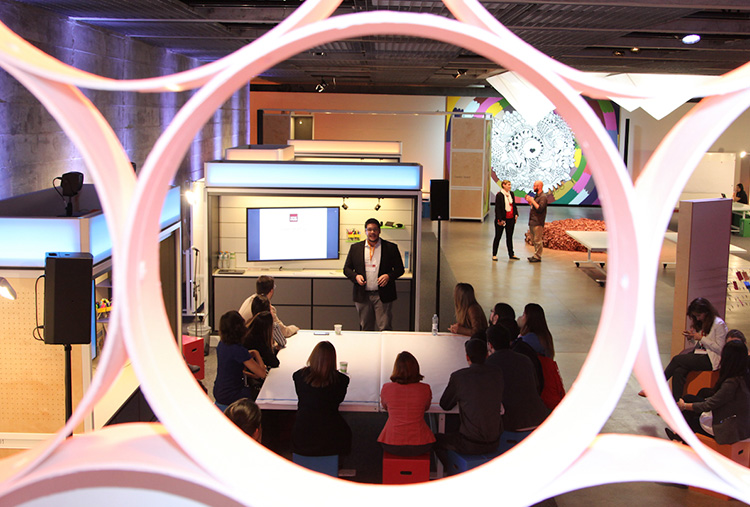
At the Brazilian Museum of Sculpture (MuBE) experts searched for innovative solutions to increase sustainability in agriculture, ensure sufficient food supply for the population, and improve quality of life in urban areas.
-
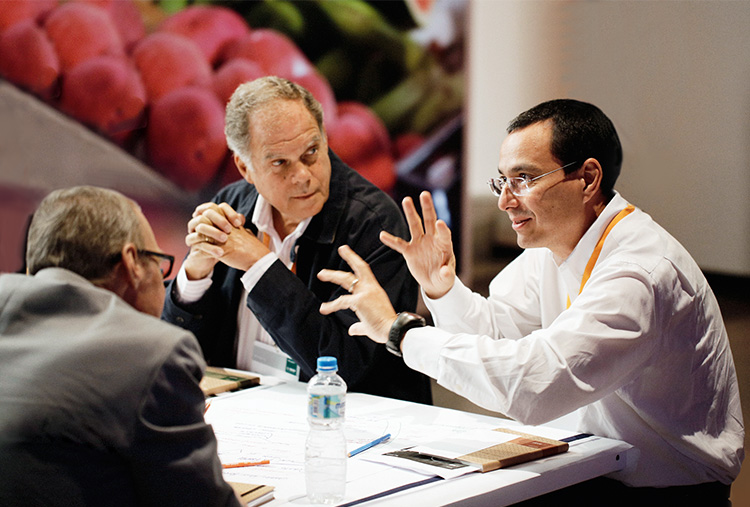
Students, environmental experts, engineers and city planners were some of the participants at a Creatathon in São Paulo that focused on solutions for more efficient water use in town and country.
-
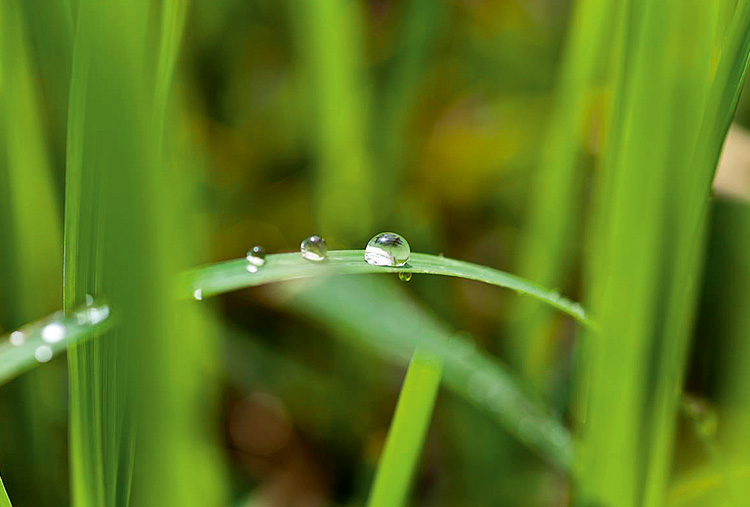
Little drops that make an impact: In many parts of South America, water is a precious commodity. New technologies aim to help keep fields irrigated even in times of lengthy drought.
-
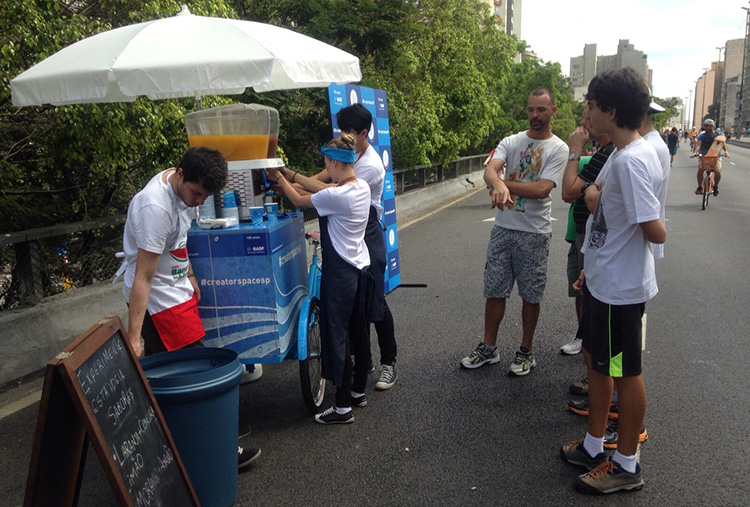
Break time in São Paulo: During the tour stop, food bikes pedaled around the city handing out juice made from leftover fruits and vegetables in order to increase awareness of the topic “avoiding food loss” among São Paulo residents.
The green way to go: Megacities like Shanghai are already home to over 20 million people today. That means public transit and other alternate modes of transportation will play an even greater role in reducing emissions in the future.
Shanghai
A clean air app
How does growing urbanization affect our planet? And how can we as individuals lead a sustainable lifestyle? These were the questions addressed at the “Creatathon” in Shanghai. The idea: People engage in a highly creative activity for a sustained, uninterrupted period of time. Just like in Shanghai, when BASF invited six college teams to spend 24 hours devoting themselves to developing an app-based, sustainable mobility solution. The goal of the app was to help city dwellers minimize their carbon footprint by selecting the most environmentally friendly mode of transportation. In the end, first place went to the team from East China Normal University: With their “Carbon Coin” idea, consumers can cash in their personal contribution to sustainability as “currency” on an online platform – similar to emissions trading between companies.
The green way to go: Megacities like Shanghai are already home to over 20 million people today. That means public transit and other alternate modes of transportation will play an even greater role in reducing emissions in the future.
A team from East China Normal University won the 24-hour Creatathon with their idea, “Carbon Coin.”
Numerous experts from research and industry, along with representatives of NGOs, came together in Shanghai to discuss urbanization and sustainable urban living in China.
At the events for Co-Creation activities, creativity and unusual methods of developing new ideas were in demand.
-
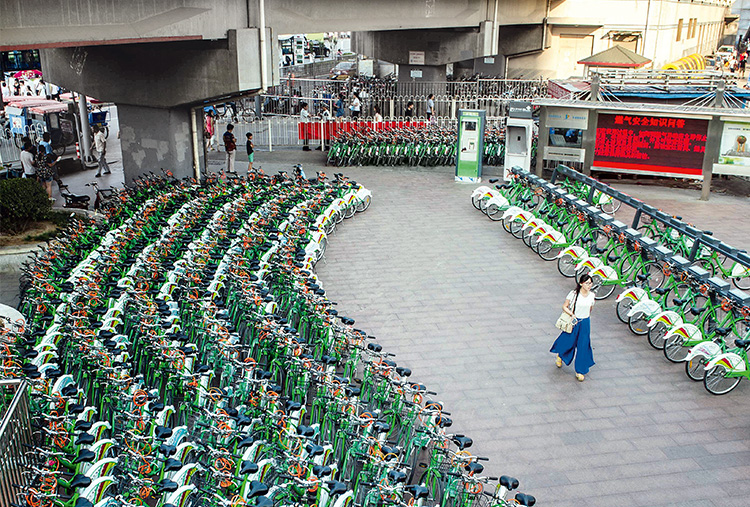
The green way to go: Megacities like Shanghai are already home to over 20 million people today. That means public transit and other alternate modes of transportation will play an even greater role in reducing emissions in the future.
-

A team from East China Normal University won the 24-hour Creatathon with their idea, “Carbon Coin.”
-
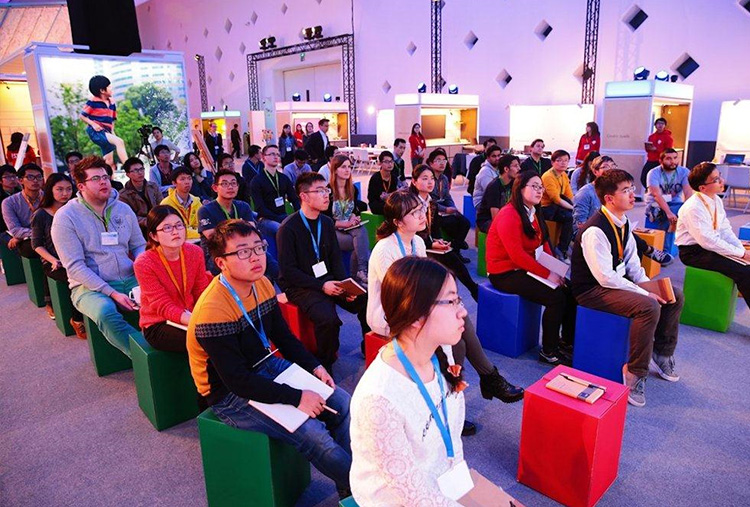
Numerous experts from research and industry, along with representatives of NGOs, came together in Shanghai to discuss urbanization and sustainable urban living in China.
-
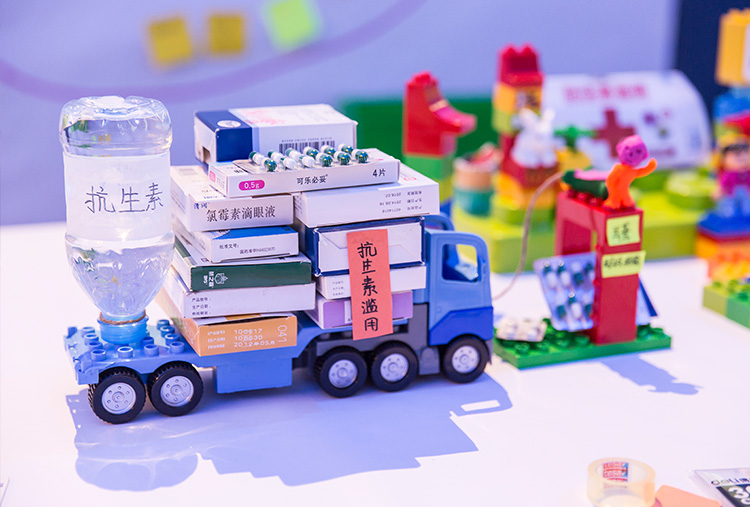
At the events for Co-Creation activities, creativity and unusual methods of developing new ideas were in demand.
